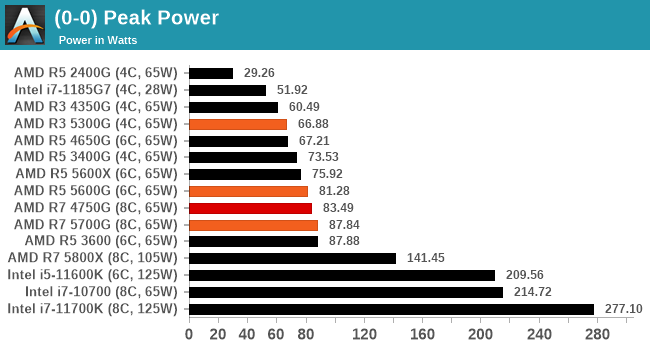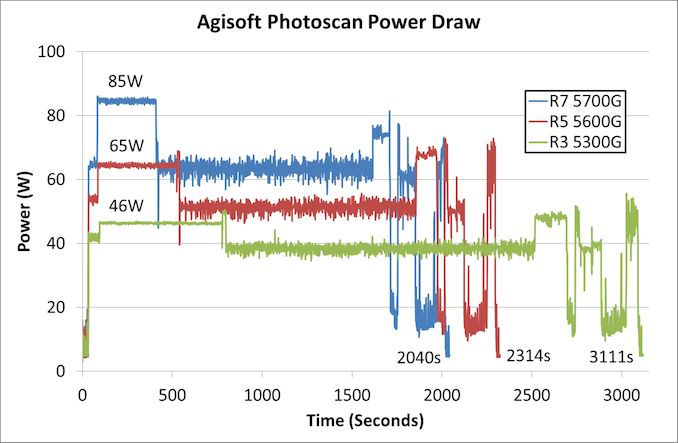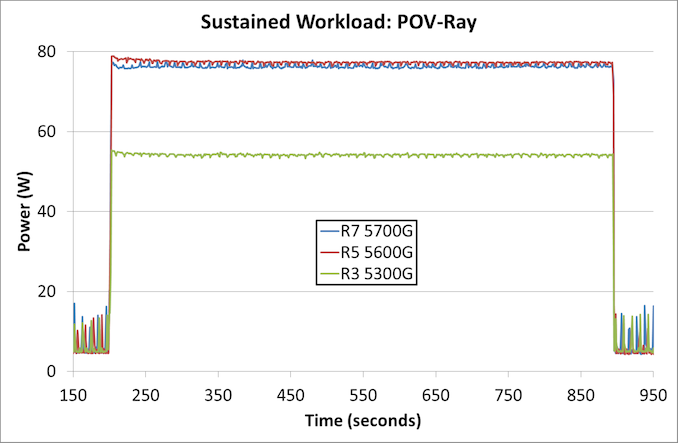The AMD Ryzen 7 5700G, Ryzen 5 5600G, and Ryzen 3 5300G Review
by Dr. Ian Cutress on August 4, 2021 1:45 PM ESTPower Consumption
The nature of reporting processor power consumption has become, in part, a dystopian nightmare. Historically the peak power consumption of a processor, as purchased, is given by its Thermal Design Power (TDP, or PL1). For many markets, such as embedded processors, that value of TDP still signifies the peak power consumption. For the processors we test at AnandTech, either desktop, notebook, or enterprise, this is not always the case.
Modern high-performance processors implement a feature called Turbo. This allows, usually for a limited time, a processor to go beyond its rated frequency. Exactly how far the processor goes depends on a few factors, such as the Turbo Power Limit (PL2), whether the peak frequency is hardcoded, the thermals, and the power delivery. Turbo can sometimes be very aggressive, allowing power values 2.5x above the rated TDP.
AMD and Intel have different definitions for TDP, but are broadly speaking applied the same. The difference comes to turbo modes, turbo limits, turbo budgets, and how the processors manage that power balance. These topics are 10000-12000 word articles in their own right, and we’ve got a few articles worth reading on the topic.
- Why Intel Processors Draw More Power Than Expected: TDP and Turbo Explained
- Talking TDP, Turbo and Overclocking: An Interview with Intel Fellow Guy Therien
- Reaching for Turbo: Aligning Perception with AMD’s Frequency Metrics
- Intel’s TDP Shenanigans Hurts Everyone
In simple terms, processor manufacturers only ever guarantee two values that are tied together - when all cores are running at base frequency, the processor should be running at or below the TDP rating. All turbo modes and power modes above that are not covered by warranty. Intel kind of screwed this up with the Tiger Lake launch in September 2020, by refusing to define a TDP rating for its new processors, instead of going for a range. Obfuscation like this is a frustrating endeavor for press and end-users alike.
However, for our tests in this review, we measure the power consumption of the processor in a variety of different scenarios. These include workflows, real-world image-model construction, and others as appropriate. These tests are done as comparative models. We also note the peak power recorded in any of our tests.
First up is our image-model construction workload, using our Agisoft Photoscan benchmark. This test has a number of different areas that involve single thread, multi-thread, or memory limited algorithms.
For the Ryzen 7 5700G, the most power-hungry part of the test is right at the beginning, where we’re seeing peaks of 85 W. For the 5600G, that first section goes to 65 W, but the peaks actually occur here near the end of the test. The 5300G also has peaks later in the test, but that first section is the lowest, running only at 46 W.
The second test is a sustained rendering workload.
In this instance, the Ryzen 3 5300G is nearer 55 W with a sustained workload over 10 minutes, while the Ryzen 5 and Ryzen 7 sit just below 80 W.
For peak power, we report the highest value observed from any of our benchmark tests.

While all three processors have a TDP rating of 65 W, by default on AMD systems the Package Power Tracking, which is the limiting factor here, is 88 W. The Ryzen 7 is practically at that value, while the Ryzen 5 just goes a smidge over 80 W. The Ryzen 3 on the other hand only matches its TDP in the worst-case scenario.












135 Comments
View All Comments
GeoffreyA - Friday, August 13, 2021 - link
SVC sounds pretty interesting, and the idea of layered encoding is becoming more common in today's codecs. I'd expect that H.265/6 and AV1 took it further. At least in their standards. Implementation is another story. Also reminds me of HE-AAC's extensions, the spectral band stuff and parametric stereo, which are just ignored by older decoders.GeoffreyA - Friday, August 13, 2021 - link
Even for files played on a TV, you've got to follow the profiles and levels, otherwise it just doesn't work. Our Samsung TV, I think I'm limited to H.264 profile high, level 4.1. Lamentably, it doesn't support H.265, which means re-encoding.GeoffreyA - Thursday, August 5, 2021 - link
Goodness, this is the one I've been waiting for! Thanks, Ian.GeoffreyA - Thursday, August 5, 2021 - link
Solid CPU performance as expected, but a bit disappointing in the GPU department, and pricing could be better. The 5300G looks like an impressive little fellow as well, perhaps even the star of today's show.yankeeDDL - Thursday, August 5, 2021 - link
Every time I see the peak-power charts it amazes me how can anyone considers Intel these days.28W burning 51W
125W burning 277W; and slower than the 5800X @ 140W.
Spunjji - Thursday, August 5, 2021 - link
It's always worth noting that the peak power on Intel chips is pretty pathological, and they tend to not go quite so high under ordinary loads. They're still lousy compared to AMD on perf/W, but they're a little better than 50% of AMD.Makste - Thursday, August 5, 2021 - link
Efficient tools. A 65W 5700G is an 11700K at 125Wabufrejoval - Thursday, August 5, 2021 - link
The price of novelty, I guess: first day of official sales, 5700G ride €70 above 5800X, nicely filling the gap to the 5900X :-)chazzzer - Thursday, August 5, 2021 - link
The 5700G is available today at MSRP on AMD's website.Spunjji - Thursday, August 5, 2021 - link
Is it possible that a follow-up could be done assessing the performance impact of RAM speeds? I'd really love to know whether it's possible to get more out of the 5300G and the 5700G in particular - potentially enough to get 60fps at 1080p with some moderate sacrifices to detail settings.